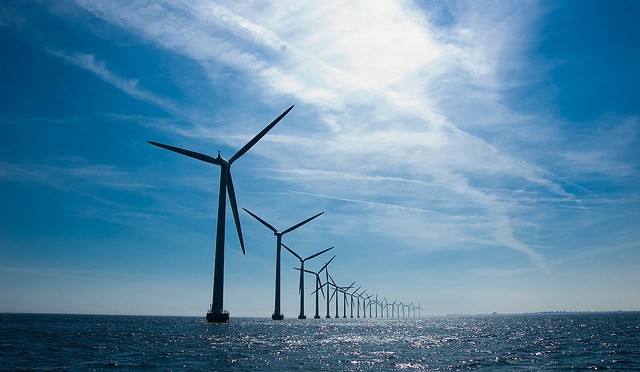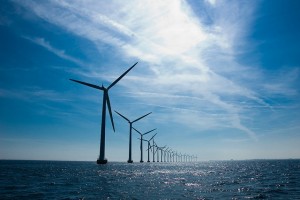Of several emerging possibilities, what’s going to dominate the next phase of U.S. wind power expansion?
That’s the question attendees at a WINDPOWER 2015 Conference & Exposition session Tuesday afternoon were asked, following presentations from speakers arguing on behalf of:
- New transmission lines (Jayshree Desai, Clean Line Energy Partners)
- Low-wind-speed turbine technology (Brian Healer, RES Americas)
- Repowering of existing wind sites (Rick Miller, EDF Renewable Energy)
- Offshore wind (Jeff Grybowski, Deepwater Wind)
In a quick-turnaround phone poll at the session’s end, attendees voted for which case they were most convinced by. It was a virtual dead heat for offshore wind, low-wind-speed technology, and new transmission. Repowering placed a distant fourth, as those present appeared to agree with Rick Miller that with only a few wind sites currently at or near the end of their design lifetimes, most repowering in the U.S. still lies some years in the future.
Offshore wind energy, which was one of the 4 competing cases, will be coming to America this summer. (Photo via Flickr user Andreas Klinke Johannsen using a Creative Commons license)
Offshore wind
Deepwater CEO Grybowski was clearly elated at having arrived, after several years, at the point where the power purchase agreements, other contracts, financing, and permits for the first U.S. offshore wind project are all in place. Paraphrasing Mark Twain, he asserted, “Reports of the demise of offshore wind in the United States have been greatly exaggerated.”
The U.S. is not unique in taking a long time to get moving on offshore wind, Grybowski said, pointing to data showing that it was a number of years after the first European offshore project before the industry began to really ramp up on the Continent.
Deepwater’s Block Island, R.I., project is in a very sweet spot for competition with other potential power providers, he added, because it lies offshore from a huge electricity demand center, the Boston-NYC corridor, which is very supply constrained. High real estate prices and tough permitting requirements stand in the way of any land-based power alternative, and in addition, the offshore area has excellent wind speeds that promise capacity factors “in the 50s,” he said. He added, “We hope the Block Island project will unleash much larger offshore projects.”
Low-wind-speed technology
RES Americas’ Brian Healer sees three major possible ways to modify existing turbine technology to generate more electricity in low-wind-speed areas:
- Increase the rotor diameter, using advanced composite materials.
- Increase the generator size.
- Increase the hub height: “It may be possible to use steel for this, but I think the consensus is generally that a hybrid approach (concrete and steel) will be needed.”
The optimum choice among these options, or some combination of them, will depend on the economics for individual wind sites, Healer said. He added, “During the 1980s and 1990s, we were developing 8-m/s and 9-m/s sites, but a lot of those are already developed and now the mean wind speed for new sites is going down. I’d say technology change is enabling that.”
While transmission can be an attractive option, Healer said, there are advantages to building wind in-state instead of importing it: “Other states are going to want the jobs, the tax payments, and the economic development and other benefits that wind brings.” He predicted more future development in the Southeast and West at sites that are “still a long way from offshore.”
(Development of new turbine technology to spread wind farms to new parts of the U.S. is a major focus of the U.S. Department of Energy’s wind research program, as discussed by Secretary of Energy Ernest Moniz in a separate WINDPOWER 2015 session.)
Transmission lines
Clean Line Energy’s Jayshree Desai said she is “very optimistic” about the prospects for new power lines from the windy Plains states to unlock new projects, adding “Demand for wind has never been stronger.”
Key ingredients for substantial expansion of wind power, Desai said, include low price, land availability to build projects at scale, and the capability to move power to demand centers in areas of the country–California and the East–that are supply constrained. Adding these together, she said, points toward long-haul transmission as the solution. Some additional reasons why:
- The Midwest has excellent wind speeds–”8.5, 9.5, in some cases 10 meters/second,” which significantly affects economics: “The difference between 8.5 m/s and 7 m/s is a 100 percent difference in energy potential.” Because of the difference in wind speeds, it’s less expensive to build a wind farm in Kansas and transmit the power to Indiana than to build the project in Indiana.
- It’s easy to build wind farms in the central U.S., where large tracts of level land are available.
- When wind farm output is averaged over a broad geographical area, through the use of transmission lines, the total output is less variable smoother and easier for utilities to integrate.
In 2014, Desai noted, the wind industry installed just under 5 gigawatts (GW) of new capacity, and “a single new line can unlock another 5 GW,” or $7 billion worth of new investment.
Repowering existing wind sites
The wind industry is beginning to see some repowering of older wind farm sites in California, said EDF Renewable Energy’s Rick Miller, due to the fact that many installations have reached the end of their 25- to 30-year design lifetimes.
- Questions for a developer considering repowering include:
- What are the local jurisdiction’s decommissioning requirements?
- What are the end-of-project requirements outlined in the project’s underlying lease agreement?
- What existing components can be salvaged? What is the disposal methodology for those that cannot?
- What due diligence is needed regarding species issues? What consultation with government agencies?
- Is the site set up for repowering?
- What is the optimal time to repower?: “Ideally, you have will have the next project ready to roll, but that’s not always possible. You may have wind site data, for example, but it’s at 40 meters and you’re now putting in turbines with tower heights of 80 or 90 meters. Is that data sufficient? The answer is no, you’re going to have to put up some new [meteorological] towers.”
- How will the existing interconnection agreement be treated?: “Normally we’re seeing the original nameplate capacity being honored, but not always. Maybe the site had an agreement for 30 megawatts (MW), but was only delivering 20 MW to the grid. In situations like that, we’re seeing some friction in getting back up to 30.”
Miller referenced a recent study by researchers at the National Renewable Energy Laboratory (NREL) looking at decision drivers for repowering and supply chain effects. Key takeaways from the report, he said, are first, that there is little incentive to repower as opposed to developing greenfield sites, and second, that more repowering will kick in after wind farms reach 25 to 30 years in age. He added, “I think we may see that extended to 30 to 35 years.”



